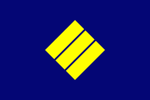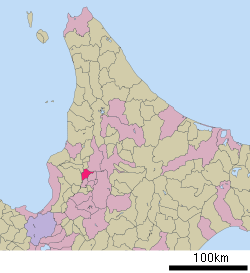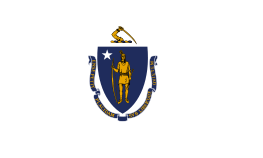Takikawa, Hokkaido
Takikawa (滝川市, Takikawa-shi) is a city located in the Sorachi Subprefecture, Hokkaido, Japan.
Takikawa 滝川市 | |
|---|---|
Takikawa City Hall | |
 Flag  Emblem | |
 Location of Takikawa in Hokkaido (Sorachi Subprefecture) | |
 Takikawa Location in Japan | |
| Coordinates: 43°33′N 141°55′E | |
| Country | Japan |
| Region | Hokkaido |
| Prefecture | Hokkaido (Sorachi Subprefecture) |
| Government | |
| • Mayor | Kōkichi Maeda (since April 2011) |
| Area | |
| • Total | 115.90 km2 (44.75 sq mi) |
| Population (December 2016) | |
| • Total | 41,306 |
| • Density | 360/km2 (920/sq mi) |
| Symbols | |
| • Tree | Platanus |
| • Flower | Azalea and Cosmos |
| Time zone | UTC+9 (JST) |
| City hall address | 1-2-15, Ōmachi, Takikawa-shi, Hokkaidō 073-8686 |
| Website | www |
Takikawa City is located in the central area of Hokkaido, it is conveniently located between the cities of Sapporo (biggest city) and Asahikawa (the second biggest city). Takikawa has an inland climate which causes great temperature difference between summer and winter. The average temperature in Takikawa is about 19 degrees Celsius in summer, and –5.9 degrees Celsius (21.4 Fahrenheit) in winter. Takikawa is one of the snowiest locations in Hokkaido, the average amount of snowfall in the past 10 years is 7.77 meters (25 feet, 6 inches).
Takikawa is also the biggest city in northern Sorachi, making it a hub for neighboring towns. Takikawa is situated between the Ishikari River and Sorachi River, about 60 percent of Takikawa is covered in greenery by either forest or agriculture farmland. Takikawa is surrounded by rich nature.
As of December, 2016, the city has an estimated population of 41,306, with 21,561 households. The total area is 115.82 km².
Origin of the name
The name of Takikawa City originates from the Ainu Language Sorapuchi which means "area under the waterfall". Also, along the mid-streams of Sorachi River, there is a difference in level which creates a mini waterfall, so the Ainu people have called it Sorapuchipetsu (Taki no kawa) which translates to Waterfall River, since then, the area has been called Takikawa.
History
In 1890, under the ordinance of Hokkaido Prefectural Government, Takikawa Village was established to be a transportation hub to support the coal production of the neighbouring towns.
- 1890 - Takikawa Village opened.
- 1906 - Takikawa becomes a Second Class Municipality.
- 1909 - Takikawa becomes a First Class Municipality. Ebeotsu Village splits off.
- 1910 - Takikawa Village becomes Takikawa Town.
- 1952 - Ebeotsu Village becomes Ebeotsu Town.
- July 1, 1958 - Takikawa Town becomes Takikawa City.
- 1971 - Ebeotsu Town merged.
Sightseeing
Lantern Festival (Late February)
The event was organised by Igarashi Takenobu, an artist born in Takikawa with the goal of giving people the joy of crafting their own piece of artwork.
It is a fantastic and heart-warming festival. Everyone can join the event as you can make paper lanterns. It is easy and simple but you'll see many artistic lanterns too. The main venue for this is Tarokichi warehouse and around Bell Road. In late February, the Lantern festival lights up the streets for a night with over 10,000 paper lanterns made by citizens of Takikawa.
* The date for the festival varies each year. Please check the official homepage for more information.
The date for 2016 is 18 February.
Nanohana Festival (Mid May – Late May)
Nanohana is the word for Canola flowers in Japanese. The festival is held at Maruka Highlands Learning Center over a weekend between mid-May and late May, a variety of specialty dishes and products made using local ingredients from Takikawa and the surrounding areas are sold. Takikawa's famous specialty dish, the Jingisukan can also be enjoyed at the festival. The flavors of the 3 brands of Jingisu Don can be tasted and enjoyed there.
As the flowers bloomed early in 2015, it was not held at the same time as the flowering season. However, when in conjunction with the flowering season, as many as 123,000 people stop by the event.
※Please note that the dates of the Nanohana Festival change depending on the blooming period of the flowers.
Places
Takikawa Sky Park /Takikawa Sky Museum
Takikawa Sky Park is located along the river bed of Ishikari River making it the only Aviation Park in Japan. At this facility, it is possible to experience a flight in a glider.[1]
Fureai no Sato-onsen
There are various types of spas, sauna, outdoor hot springs at Fureai no Sato. These springs contain minerals that can soothe the skin, easing stiff shoulders and relaxing muscles.[2]
Takikawa Art and Natural History Museum
In the natural history area, starting with a full-fledged Takikawa sea cow specimen, many fossil and skeletal specimens are on display. In the art area, Japanese style painter Iwahashi Eien and other artists and writers related to Takikawa have their works on display here.
Takikawa Regional History Center (Open from May to September)
From the pioneering days during the early Meiji period, Takikawa's history is displayed here in an easy to understand exhibition of memoribiila from the early days including the variations of the pot used to cook Jingisukan.
Children's Science Museum
A moving globe will showing the shifting tectonic plates of the continents is displayed at this museum.
http://www.city.takikawa.hokkaido.jp/260kyouiku/05bijyutsu/k-museum.html
Maruka Highlands-Cloud Terrace (Unkai)
At Maruka you can see the whole of Takikawa from the top of the hill, For example, you can see Ishikari River, rice paddy fields, farms, Shokandake, Pinneshiri and so on. Marukayama is in Ebeotsu, north-east of Takikawa. Also, from mid-summer to late autumn, you can also see the unkai granted the weather conditions are right.
“Unkai” is a Japanese word for a sea of clouds which is a natural phenomenon that forms by radiative cooling at night.
In Takikawa, the temperature variation during the day and night is large, along with the condensation from the surrounding rivers forming stratocumulus clouds (the puffy clouds), it makes it a hidden spot to see the Unkai.
B&G Canoe and Yacht Center
Located on the Raune River, single and pair canoes are available here. The B&G Canoe and Yacht Center offers professional instruction, allowing novices to experience canoeing, yachting, and other water sports with ease.
Matsuo Jingisukan BBQ
Marinated lamb meat in Hokkaido is called Jingisukan. There are 2 ways of eating Jingisukan. One of the ways is to grill the lamb meat and dip it in special tare or marinade. This is commonly found in places such as Sapporo. However, grilling of ready marinated lamb meat to eat Jingisukan is said to originate from Takikawa City. Matsuo Jingisukan, one of the most famous Jingisukan restaurants in Hokkaido has its main shop and factory based in Takikawa. At Matsuo, the meat is usually grilled together with vegetables over a large stone pot. The tare from the ready marinated meat spills over onto the vegetables making the dish very tasty as a whole.
Jingisukan meat in Takikawa City is marinated with apples, onions, ginger, soy sauce and many condiment spices to create a unique taste. While in Hokkaido, definitely try out the different ways of eating Jingisukan!
Transportation
- Takikawa is 90 minutes away by JR or by car from New Chitose Airport. Takikawa is 50 min away by JR or 75 min by car from Sapporo City. Takikawa is 30 min away by JR or 80 min by car from Asahikawa Airport. Furano is also just 50 min away by car.
- Hakodate Main Line : Takikawa - Ebeotsu
- Nemuro Main Line : Takikawa - Higashi-Takikawa
- Hokkaidō Expressway : Takikawa IC
Sister cities




References
- http://takikawaskypark.com/
- http://takikawa-fureainosato.com/
- Sister cities of Takikawa
- "Archived copy". Archived from the original on 2013-05-21. Retrieved 2012-04-04.CS1 maint: archived copy as title (link)
External links
| Wikimedia Commons has media related to Takikawa, Hokkaidō. |
- Official Website (in Japanese)